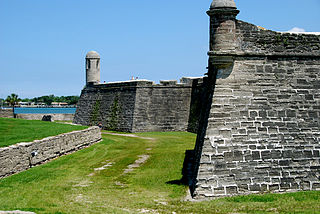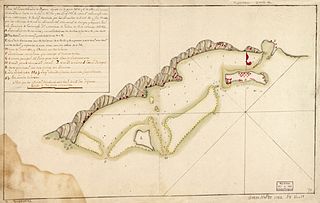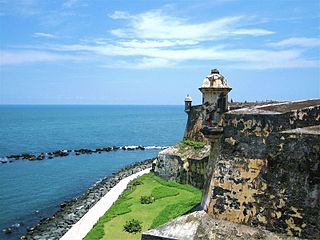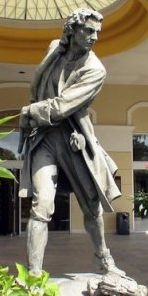
The Siege of St. Augustine was a military engagement that took place during June–July 1740. It was a part of the much larger conflict known as the War of Jenkins' Ear, between Great Britain and Spain.

The Blockade of Porto Bello was a failed British naval action against the Spanish port of Porto Bello in present-day Panama between 1726 and 1727 as part of the Anglo-Spanish War. The British were attempting to blockade the port to stop valuable treasure convoys leaving for Spain. After months spent on the ineffective and costly operation, during which not a single British shot was fired, on Admiralty orders, the British finally withdrew, with the loss from tropical disease of some 3,000 to 4,000 men from a complement of 4,750.

The First Cevallos expedition was a military action between September 1762 and April 1763, by Spanish colonial forces led by Don Pedro Antonio de Cevallos, Governor of Buenos Aires, against Portuguese colonial forces in the Banda Oriental area on the aftermath of the Spanish and French Invasion of Portugal (1762), as part of the Seven Years' War.
HMS Salisbury was a 50-gun fourth rate ship of the line of the Royal Navy, built at Chatham Dockyard to the dimensions of the 1706 Establishment, and launched on 3 July 1707. In autumn of 1707, she brought the body of admiral Sir Cloudesley Shovell from St Mary's to Plymouth prior to his burial in Westminster Abbey.
Michiel Andrieszoon was a Dutch buccaneer who served as lieutenant to Captain Laurens de Graaf. He commanded the le Tigre, which had a 300-man crew and was armed with between 30-36 guns. He is occasionally referred to in English as Michel or Mitchell, and is often erroneously given the nickname "Bréha Michiel".

The Battle of Roatán was an American War of Independence battle fought on March 16, 1782, between British and Spanish forces for control of Roatán, an island off the Caribbean coast of present-day Honduras.

The Battle of La Guaira or La Guayra, took place on 2 March 1743 in the Caribbean, off the coast of La Guaira, present day Venezuela. La Guaira was a port of the Royal Gipuzkoan Company of Caracas, whose ships had rendered great assistance to the Spanish navy during War of Jenkins' Ear in carrying troops, arms, stores and ammunition from Spain to her colonies, and its destruction would be a severe blow both to the Company and the Spanish Government. A British expeditionary fleet under Sir Charles Knowles was defeated, and the expedition ended in failure. 600 men were killed, among whom was the captain of HMS Burford, and many of the ships were badly damaged or lost. Sir Charles was therefore unable to proceed to Puerto Cabello until he had refitted.
The Battle of Puerto Cabello was an attack on a Spanish colonial port during the War of Jenkins' Ear on 16 April 1743 and resulted in another defeat of British forces.

The invasion of Cuba took place between 4–5 August and 9 December 1741 during the War of Jenkins' Ear. A combined army and naval force under the command of Admiral Edward Vernon and Major-General Thomas Wentworth arrived off Cuba and fortified positions around their landing site at Cumberland Bay. Despite facing no serious opposition, neither commander felt prepared to advance on the Spanish settlement at Santiago de Cuba. Harassed by guerrilla raids and with a mounting sick list, the British finally evacuated the island after several months of inactivity.

The Battle of St. Kitts or St. Cristopher was a successful Spanish expedition that seized the islands of Saint Kitts and Nevis from the English and French during the Anglo-Spanish War (1625–30).

The Capture of the Bahamas took place in May 1782 during the Anglo-Spanish War when a Spanish force under the command of Juan Manuel Cajigal arrived on the island of New Providence near Nassau, the capital of the Bahamas. The British commander at Nassau, John Maxwell decided to surrender the island without a fight when confronted by the superior force.

The Battle of Rio Nuevo took place between 25 and 27 June 1658 on the island of Jamaica between Spanish forces under Cristóbal Arnaldo Isasi and English forces under governor Edward D'Oyley. In the battle lasting over two days the invading Spanish were routed. It is the largest battle to be fought on Jamaica.

The Capture of the Bahamas took place in April 1783, late in the Anglo-Spanish War, when a Loyalist expedition under the command of Andrew Deveaux set out to retake the Bahamas from the Spanish. The expedition was successful and Nassau fell without a shot being fired. It was one of the last actions of the entire war.

Part of the Eighty Years' War, the Capture of Saint Martin was a Spanish naval expedition against the island of Saint Martin occupied by the Dutch Republic and administered as part of the Dutch Antilles. The island, claimed by Spain since Christopher Columbus' second voyage to the West Indies in 1493, lies a few hundred miles east of Puerto Rico. The capture eliminated the presence of Dutch privateers in the island, weakening Dutch privateering and commerce in the Caribbean.

The Raid on Nassau, on the Bahamian island of New Providence, was a privately raised Franco-Spanish expedition against the English taking place in October 1703, during the War of the Spanish Succession; it was a Franco-Spanish victory, leading to Nassau's brief occupation, then its destruction. The joint Bourbon invasion was led by Blas Moreno Mondragón and Clause Le Chesnaye, with the attack focusing on Nassau, the capital of the English Bahamas, an important base of privateering for English corsairs combating the privateering of others in the Cuban and Saint Domingue's Caribbean seas. The town of Nassau was quickly taken and sacked, plundered and burnt down. The fort of Nassau was dismantled, and the English governor, with all the English soldiers were carried off prisoners. A year later, Sir Edward Birch, the new English governor, upon landing in Nassau, was so distraught at the ruin he found, that he returned to England after only a few months, without "unfurling his company-issued commission".

The capture of Demerara and Essequibo was a French military expedition carried out in January 1782 as part of the Anglo-French War. In 1781, Admiral Lord Rodney sent two sloops from his fleet at Sint Eustatius to take possession of the Dutch colonies of Essequibo and Demerara. In 1782, the French successfully took possession of these settlements, compelling British Governor Robert Kinston to surrender. The Peace of Paris, which occurred in 1783, restored these territories to the Dutch.
The Attack on Saint Martin was a failed attempt by the Dutch Republic to recapture the island and former base of the Dutch West India Company (WIC) from the Spanish. In 1633 the Spanish had invaded Saint-Martin and Anguilla, driving off the French and Dutch inhabitants. The French and Dutch banded together to repel the Spanish and it was during a 1644 sea battle that the Dutch commander Peter Stuyvesant, later the governor of New Amsterdam, unsuccessfully besieged Fort Amsterdam and was forced to retreat with the loss of hundreds of men. A stray Spanish cannonball shattered his leg, which had to be amputated. But luck was on the Dutch side, and when the Eighty Years' War between Spain and the Netherlands ended, the Spanish no longer needed a Caribbean base and just sailed away in 1648.

The Capture of Port Egmont on 10 June 1770 was a Spanish expedition that seized the British fort of Port Egmont on the Falkland Islands, garrisoned since 1765. The incident nearly led to an outbreak of war between Great Britain and Spain, known as the Falklands Crisis.

The raid on Cartagena was the successful counter-attack against vessels sent to defend the city of Cartagena de Indias and the subsequent blockade of the city by Laurens de Graaf and his pirate compatriots.





















